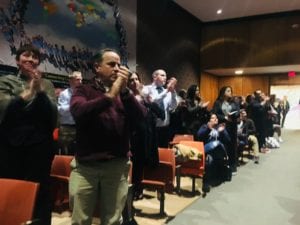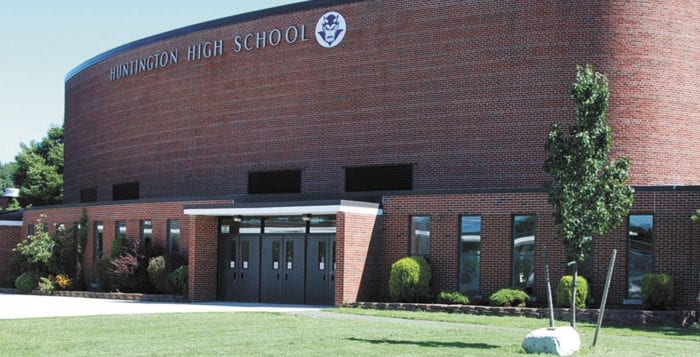Huntington reacts to NY Times Magazine article on MS-13 and immigrants
An outpouring of anger, tears and frustration rocked Huntington Monday night as hundreds of residents expressed concern about an article published by The New York Times Magazine during the school’s holiday break.
There was standing-room only inside the auditorium of Jack Abrams STEM Magnet School Jan. 7 as parents, teachers and students lined up to address Huntington school district’s board of education in reaction to the Dec. 27 publication of the article, “How a crackdown on MS-13 caught up innocent high school students,” written by ProPublica reporter Hannah Dreier.
The Times article focused on the experience of an immigrant teenager at Huntington High School, named Alex, who was detained by U.S. Immigration and Customs Enforcement officers in June 2017 for suspected MS-13 gang affiliation. The story alleges Huntington school district’s school resource officer, Suffolk County police officer Andrew Fiorello, provided information and school documents to ICE that led to the student’s deportation in July 2018.
“The issue is very clear: Our classmates are being accused of participating in gang activity on evidence that does not prove their involvement beyond a reasonable doubt,” Steve Yeh, Huntington’s Class of 2017 valedictorian said. “Our school failed to protect our classmate.”
The facts questioned
Brenden Cusack, principal of Huntington High School, was the first to step forward Monday night to refute the magazine piece he claims “mischaracterizes” events portrayed.
“It is a clear misrepresentation of our school and of me, both personally and professionally,” he said. “The story as published is not the full story.”
In the article, Cusack reportedly wrote up Alex for allegedly defacing school property — a calculator — with gang symbols. The article states he informed the student it would be reported to the school resource officer.

The high school principal did not address the facts behind the immigrant teen’s case before the crowd gathered, citing student privacy laws.
“While it would be simple to argue statements and context in numerous places within the article, it does not change the fact that the events, as presented, are beyond upsetting,” read a Dec. 28 letter issued by the school district in response to the article. “We deeply regret the harm faced by any family in our community who has been separated from a child.”
This sentiment was echoed again by Huntington’s Superintendent of Schools James Polansky Monday night.
“There are many things about it that are deeply upsetting,” he said.
Huntington school district’s staff is not the only source used in the magazine article upset with the portrayals in the piece. Joanne Adam, director of Huntington Public Library, said the article claims its head of security banned students who have been suspended from school for suspected gang activity is untrue.
“It’s not our policy to ban people simply because they might be suspected of being in a gang,” Adam said.
Both library branches, Huntington and Huntington Station, are staffed by in-house security personnel and do not have any specific policies with regards to handling gang violence, according to Adam. In the last four years, she said she could not recall any incidents where Suffolk County Police Department was contacted for any related gang activity.
“If someone is suspected of being in a gang and using the library, they are just as welcome to use it as the next person,” Adam said. “So long as they are coming in and using a library as they should be.”
Immigrant students voice fears
Huntington High School students decried the current atmosphere and actions they’ve seen made by school officials in their interactions with immigrants and students of racial minorities.
“I know what it’s like to be a Latino in Huntington,” Landary Rivas Argueta, a 2016 Huntington graduate said. “It’s not welcoming, it’s not safe, it doesn’t feel like home anymore.”
More than a dozen recent high school graduates, collaborating as the Concerned Alumni for Protecting Our Classmates, say regardless of the factual truths in the Times article they have concerns over the adequacy of services provided for immigrant students and the district’s treatment of racial minorities.
“I know what it’s like to be a Latino in Huntington. It’s not welcoming, it’s not safe, it doesn’t feel like home anymore.”
—Landary Rivas Argueta
“We believe the school administration is responsible for providing a safe environment for all students to learn and grown,” read a Jan. 7 written statement to Huntington’s school board. “We were appalled to discover that not all of our peers felt a shared sense of safety.”
Savannah Richardson is a 2016 graduate who was enrolled in the district’s dual-language program as a Mexican immigrant whose picture hangs on a banner over Jack Abram’s auditorium.
“For years, I believed the [school resource officer] was placed there to protect us,” Richardson said. “I was never aware information shared with the SRO would end up in the hands of ICE.”
Xavier Palacios, a Huntington school trustee who privately practices as an immigration attorney, was quoted in the Times article. He said the information sharing was between the district’s school resource officer and ICE was not done with purposeful intent to harm.
“What happened to Alex was an unfortunate series of events of unintended consequences — I don’t think anyone meant to harm him,” Palacios said. “The truth is procedures failed Alex and possibly other students and we must change that.”
But Huntington parent Josh Dubnau said he first reached out to Huntington’s administration via email with concerns about the relationship between Suffolk’s school resource officer program and ICE over the summer, following a PBS “Frontline” documentary titled “The Gang Crackdown,” regarding treatment of immigrants and suspected MS-13 members, that ran in February 2018.
After several email exchanges with Polansky, Dubnau said he was reassured the district’s students safety was protected without a loss of rights.
“My trust in you [Polansky] at that time is something I deeply regret,” Dubnau said. “This school board and administration needs to re-earn our trust and it will be a challenge for you to do so.”
Suffolk’s SRO program
Polansky said Huntington school district has been involved in the county police department’s school resource officer program for more than 15 years. The program places uniformed police officers inside public school buildings to serve as points of contact between the school district, its staff and students, and other law enforcement officials in order to increase school safety.
“I think the role of law enforcement in schools in today’s political climate is open to considerable debate.”
— James Polansky
“I think the role of law enforcement in schools in today’s political climate is open to considerable debate,” the superintendent said.
Polansky sits on the executive board of Suffolk County Schools Superintendents Association, an organization of school administrators representing the county’s 69 school districts. The association has repeatedly called on the police department to further expand the SRO program, most recently as part of its blueprint for enhancing school safety.
“Part of our mission is to keep schools and campuses safe,” Elwood Superintendent Kenneth Bossert said in a phone interview. Bossert is president of the county schools superintendents association. “Having a strong collaborative relationship with the police force and having officers present in the building who are familiar with the campus, familiar with emergency response plans, familiar with faculty and students, go a long way to ensure the safety of our students.”
School resource officers are employees of the police department, not the school district, and there is no formal agreement as to the position’s duties and responsibilities, according to Bossert.
“I think those folks who right now have some real concerns about the presence of police officers don’t necessarily have an understanding of that job,” he said. “If they did have a better understanding of the role and responsibilities of an SRO it would help alleviate some of the concerns being expressed in my neighboring community.”
The superintendents association has called for formal written document of an SRO officer’s “role and responsibility” dating back to a May 2018 letter sent out to Suffolk Executive Steve Bellone (D) and the police department. Still, nothing concrete has been developed as to date.
“We need clarity and guidelines. If we can’t get those, I am not comfortable having those officers in our buildings going forward.”
— Jennifer Hebert
“We need clarity and guidelines,” Huntington trustee Jennifer Hebert said. “If we can’t get those, I am not comfortable having those officers in our buildings going forward.”
There is no law mandating that school districts participate in the SRO program, according to Bossert, but he is not aware of any district that has voiced opposition to being a participant.
“I urge this board to carefully consider any decisions and weigh the long-term consequences against the perceived short-term benefits,” said James Graber, president of the Associated Teachers of Huntington. “A year ago, there were calls for more security in this school district because of the incident in Parkland [Florida]. To move in the other direction would be a mistake.”
Future of SRO program in Huntington
Huntington school administrators said they’ve seen the immediate need to review its existing policies and procedures, particularly when it comes to the role of its school
resource officer.
“In light of current national and local concerns, however, we believe that we must advocate for an additional layer of organization addressing the relationship between school districts and the police department,” read the Dec. 28 letter to the community. “This can be accomplished through formulation of a memorandum of understanding.”
Huntington parents and community members came to the meeting Jan. 7 armed with a detailed list of suggestions of what should be in the proposed agreement between the school district and Suffolk’s police department.
Diana Weaving, of Huntington, presented school trustees with detailed suggestions from a concerned citizens group regarding the treatment of immigrant students and the duties of the SRO officers. It suggested the memorandum of understanding includes extensive data collection including the number of times law enforcement is called to Huntington schools, number of arrests, which arrests were school-related offense, the location and date of offense and note of the involved student’s age, race, ethnicity, gender and English language learner status.
In light of current national and local concerns, however, we believe that we must advocate for an additional layer of organization addressing the relationship between school districts and the police department.”
— Huntington school district Dec. 28 letter
Weaving requested the district provides SROs, security guards and school staff with more extensive training in cultural competency, racial bias and prejudice, and restorative justice.
Aidan Forbes, Huntington’s Class of 2018 valedictorian and member of Concerned Alumni for Protecting Our Classmates, called for more in-depth investigation of a student’s character before they are reported to an SRO along with changes to the district’s suspension policies. Zach McGinniss, also a 2018 graduate, demanded more cultural training for SROs and issued a request the school district not share student’s information with third parties — including ICE — without court order or consent of a student’s parents.
All involved called for a written contract, or memorandum of understanding, to be drafted as soon as possible. The superintendent said it will necessitate a process involving community input to draft an agreement, and it will require both Suffolk police department and the school district to come to the table. He cited some Nassau County school districts which have documents that can be used as examples, but each must be uniquely catered to each individual district.
Polansky said he envisions the proposed document could be used as a template that could be used by other Suffolk schools. Trustee Hebert agreed, saying Huntington must make every possible effort to transform the SRO system into a better program.
“I see us as being given the mandate of having to figure this out for everyone else,” Hebert said. “And we will.”
Huntington school board will further discuss the SCPD’s SRO program at their upcoming February meeting.







